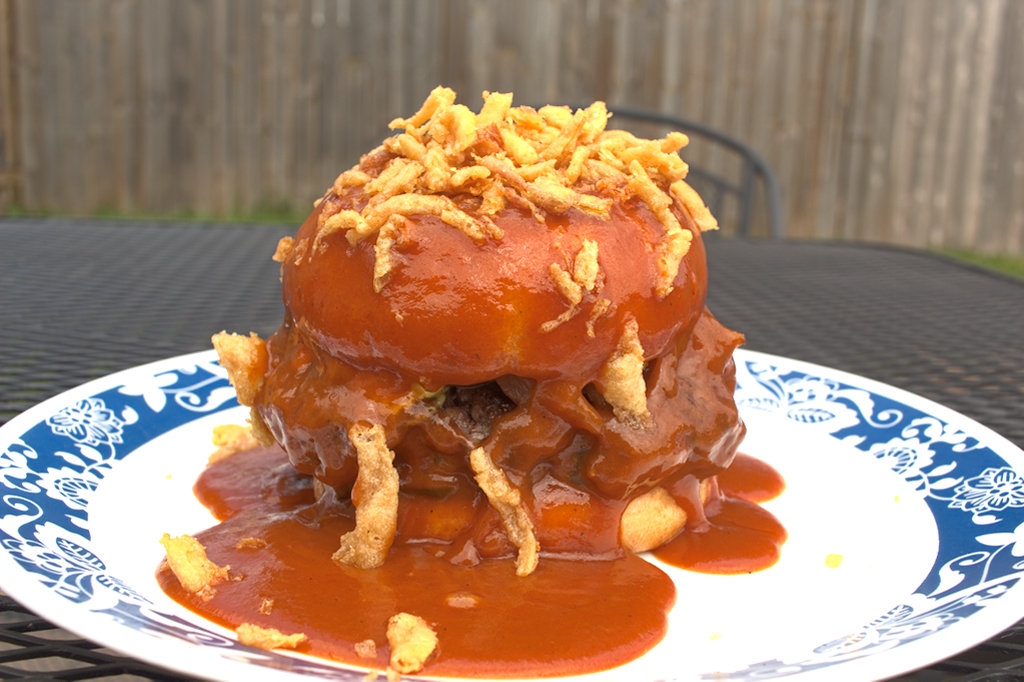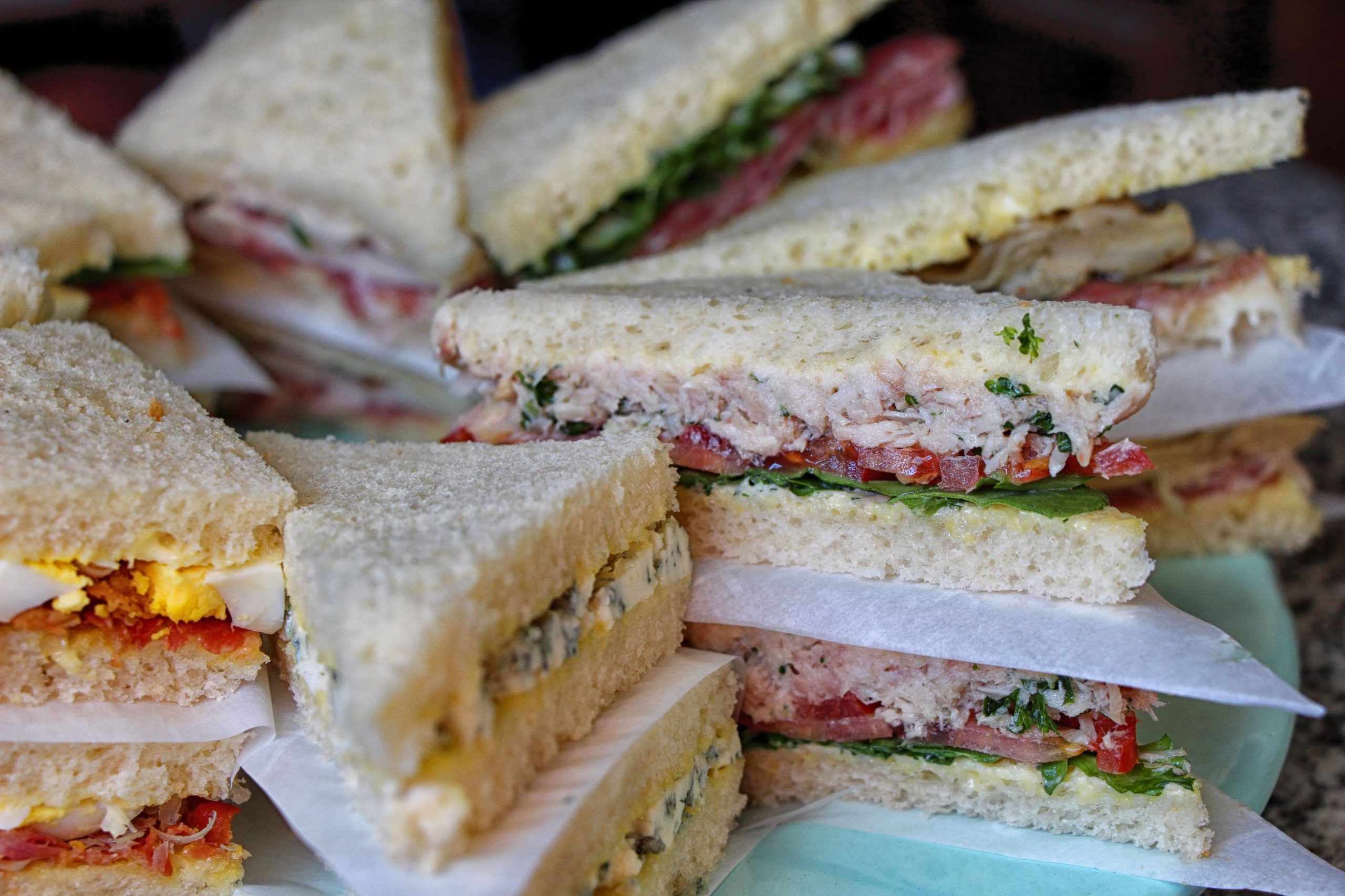Utah’s Pastrami Burger
In some ways, the hamburger is the culmination of millennia of culinary history, with two chains of causality converging–a line of events inconsequential and impossible to trace, stretching from the beginnings of cattle domestication in Stone Age Mesopotamia and the development of minced meat dumplings in ancient China, through the advent of kebabs and the subsequent spread of minced meats to Europe, where the German meatballs called Frikadelle grew larger and rounder and came to America as Hamburg steaks; and another equally untraceable path leading from the Neolithic crumbs of cooked flatbreads left behind by Levantine hunter-gatherers through the eventual cultivation of wheat in the Fertile Crescent and many thousands of years of improvements that have refined breadmaking to the nexus of art and science it currently inhabits. Somewhere in America in the late 19th Century–many different tales are told, each of them as likely as the next–that prehistoric urge to consume tasty bits of burnt flesh met the equally ancient street food impulse to eat on the go, and the Hamburg steak was introduced to the warm embrace of a bready bun, thus forming J. Wellington Wimpy’s perfect food, the Hamburger.
And in other ways, we have for the past century-and-a-half continued to add to, futz with, improve or sometimes just complicate that simple synthesis of beef and bread. Cheese, of course, was among the first enhancements to the hamburger, coming along as early as the 1920s, with multiple claims to its origin–though the term cheeseburger was trademarked by the Humpty Dumpty Drive-in in Denver. Ptomaine Tommy’s and other Los Angeles joints served cheeseburgers smothered in chili starting not long after. Of course the true innovators added more meat to the sandwich–Bob’s Big Boy innovated the double cheeseburger in 1937, and A&W lays claim to the invention of the bacon cheeseburger in 1963.
Less widespread as a burger topping are other types of cured meats. Just this past weekend, I was in Spokane Washington for a family event and on Saturday evening, tired and hangry and desperate for something, anything to eat, I ordered the signature “Papa Joe” burger from a local chain called Zip’s. I was, at the time, far too morose to think to photograph the thing, but it consisted of a small, thin fast food-style burger patty somewhat dwarfed by the steamed bun it was served in, with mayonnaise and shredded iceberg lettuce below the patty and a slice of melted cheese on top, crowned by a single, thin slice of perfectly circular, Carl Buddig-style ham.

Which leads us to today’s topic: the Pastrami burger. Unlike the overall history of hamburgers, the timeline for these treats is relatively uncontested–they were invented by Greek restaurateur James Katsanevas at Minos Burgers in Anaheim, California. When his relatives the Katzourakis opened Crown Burgers in Salt Lake City, Utah in the 1970s, they also added the Pastrami burger to their menu. Here it took off, to the point where the Pastrami Burger is often cited as the signature sandwich of the state of Utah.
From what I’ve seen, the construction is relatively simple. It’s a burger patty, often a medium fast food-style patty of 3 ounces cooked on a griddle, with melted cheese served in a toasted bun–often a sesame seed bun though that is not necessarily a requirement of the style–with fry sauce, shredded lettuce, onion, perhaps pickle or tomato. Some renditions will use more typical mayonnaise/ketchup/pickle/onion/tomato/lettuce/mustard condiments, but fry sauce is Utah’s other great contribution to American cuisine and I feel should be honored in this sandwich as well.
I used 3 ounce patties of 80/20 ground chuck cooked smashburger style, with Land O’Lakes American cheese and thin slices of navel pastrami from Bergstein NY deli, also heated in a pan.



My pastrami burger build: pan-toasted sesame-seed bun, fry sauce on top and bottom; shredded iceberg lettuce, sliced onion, and pickle chips; burger, cheese, and pastrami.






If this burger seems like a lot–you’re right, it is. A lot of delicious things that don’t necessarily need to go together, but somehow work anyway. I think it’s the fry sauce that ties the whole thing together–my fry sauce is equal parts mayonnaise (I used Duke’s, which is usually what I have onhand) and ketchup (Heinz) with a drizzle of pickle brine (Vlasic Zesty Dill to be precise), a few dashes of Worcestershire sauce and a sprinkling of onion powder. It’s a bit sweeter than a Russian dressing but has more zip than Thousand Island; it works with the pastrami, the American cheese, the burger patty, even the pickles and onion slices. The fry sauce is the bridge that keeps this whole sandwich together.

The pastrami adds an extra savory, salty, beefy element to a sandwich already based in beefiness–a smoky, salty, peppery flavor akin to the bacon of a bacon cheeseburger, sure, but without the crisp/chewy textural element and the lushness of pork fat. It adds bulk to the sandwich, almost like the second patty of a double cheeseburger, but a chaotic, disordered bulk, not the flat predictability of stacked patties but rather a jumbled pile of thin curled strips of pastrami. It doesn’t need to be there–a cheeseburger is a perfect and complete object all on its own–but it does add something, make something new. This is not just a burger with pastrami in it. It is a pastrami burger.
But what would fry sauce be without fries? I’m not usually a crinkle-cut guy but when you want to use fries as a vehicle to scoop sauce into your mouth, crinkles are the go-to.



But I may be mythologizing this burger more than it deserves. The version I made at home this month was certainly a terrific meal, but the same kind of tryhard, cheffy take I always do on what is essentially a simple Rocky Mountain fast food burger, something quickly assembled and wrapped in wax paper before being eaten behind the wheel of a used Ford F-150 while driving the kids to hockey practice.
So any Utahns out there who may be reading this? What do you think of the pastrami burger? And how did I do?

I like sandwiches.
I like a lot of other things too but sandwiches are pretty great





Chiming in as an adopted Utahn (wife’s family were first generation Mormon settlers in the 1840’s.) I’ve eaten two different takes on the pastrami burgie – Crown’s and a gastro-pubb-y number at a tourist-y spot in Park City. I’d say your cheffy rendition might skew closer to Crown’s tbh – on par with yours weight-wise and griddled to order. They use a pretty industrial, thinly sliced pastrami though, which does add the salty, beefy chaos you described. The gastro version did not work as well – the 8+ oz bloody pub patty took center stage, concealing the interplay of the salty pastrami, gooey cheese, and maillard. Overall, I’m a fan, though fortunately for my blood pressure, I only get the chance to eat one once every year or two.